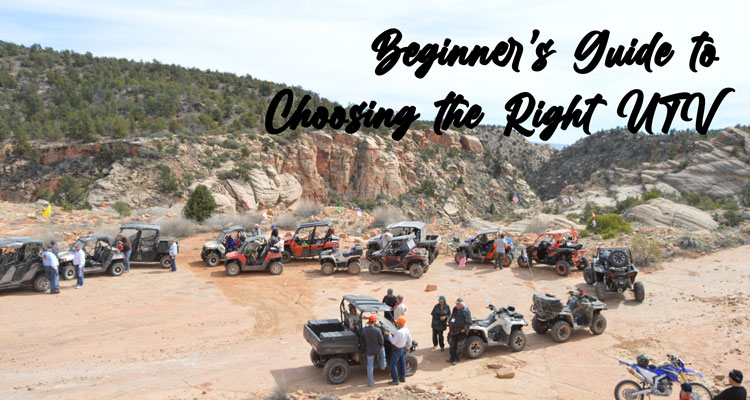Blog
Beginner’s Guide to Choosing the Right UTV
Choosing the right UTV can be daunting, especially for beginners. UTVs are versatile vehicles that can be used for a variety of activities, including recreation, work, and hunting. With so many models and features available, it’s important to understand what to look for when selecting the right UTV for your needs. This guide will walk you through the essential considerations to help you make an informed decision.
Understanding the Types of UTVs
Before diving into specific features and models, it’s important to understand the different types of UTVs available:
- Sport UTVs: These UTVs focus on high-speed performance and agility. They are ideal for recreational activities like trail riding, racing, and dune bashing. Sport UTVs typically have powerful engines, advanced suspension systems, and sleek designs.
- Utility UTVs: Built for work, these UTVs are perfect for tasks such as farming, construction, and hauling. They emphasize durability, payload capacity, and towing power over speed and agility.
- Crossover UTVs: These vehicles combine features of both sport and utility UTVs, offering a balance of performance and practicality. They are versatile and used for a variety of activities, making them a great choice for those who want an all-around vehicle.
Key Features to Consider
When choosing a UTV, consider several key features to ensure it meets your needs:
- Engine Size and Power: The engine size, measured in cubic centimeters (cc), directly impacts the UTV’s power and performance. For recreational use, a smaller engine (under 500cc) may suffice. However, we usually recommend a larger engine (700cc and above) for heavy-duty work or high-speed activities.
- Seating Capacity: UTVs come in various seating configurations, typically ranging from two to six seats. Consider how many passengers you will regularly transport. If you often ride with family or friends, a UTV with more seats is essential.
- Payload and Towing Capacity: If you plan to use your UTV for hauling or towing, pay attention to its payload and towing capacities. These specifications indicate how much weight the UTV can carry and tow. Ensure the UTV you choose can handle your intended loads.
- Suspension System: A good suspension system is crucial for a comfortable ride, especially on rough terrain. Look for UTVs with adjustable suspension systems that allow you to fine-tune the ride quality based on the terrain and load.
- Transmission Type: UTVs typically have either automatic or manual transmissions. Automatic transmissions are easier to use and more suitable for beginners, but experienced riders may prefer manual transmissions because they offer more control.
- Four-Wheel Drive (4WD) vs. Two-Wheel Drive (2WD): A 4WD UTV is essential for off-road adventures and challenging terrain. It provides better traction and stability. However, a 2WD UTV may suffice for flat and smooth surfaces.
- Safety Features: Safety should be a top priority when choosing a UTV. Look for models with safety features such as roll cages, seat belts, doors, and robust braking systems. Some advanced models also offer electronic stability control and traction control.
Brand Comparisons
With numerous brands on the market, it’s important to compare the leading manufacturers to find the right UTV for your needs:
- Polaris: Known for its wide range of models, Polaris offers both sport and utility UTVs. The RZR series is popular for recreational use, while the Ranger series is favored for work-related tasks.
- Can-Am: Can-Am UTVs are renowned for their powerful engines and advanced technology. The Maverick series is a top choice for sport enthusiasts, and the Defender series excels in utility.
- Honda: Riders celebrate Honda UTVs for their reliability and durability. The Pioneer series offers a range of models for recreational and utility purposes.
- Yamaha: Yamaha’s Wolverine and Viking series provide excellent performance and versatility. Yamaha is also known for its innovative design and durable construction.
- Kawasaki: Kawasaki’s Teryx and Mule series are known for their toughness and capability. The Teryx is a great option for off-road adventures, while the Mule is ideal for heavy-duty work.
Budgeting and Financing
Setting a budget is crucial when choosing a UTV. Prices can range from a few thousand dollars to over $20,000, depending on the model and features. Consider additional costs such as insurance, maintenance, and accessories. If purchasing a new UTV is beyond your budget, consider looking for used models or exploring financing options.
Test Driving and Research
Before making a final decision, test driving a few UTVs is important. This will give you a feel for their handling, comfort, and performance. Additionally, read reviews and seek advice from experienced UTV owners. Online forums and UTV clubs can be valuable resources for firsthand information and recommendations.
Choosing the right UTV involves understanding the different types, considering key features, comparing brands, and setting a budget. By taking the time to research and test-drive various models, you can find the UTV that best suits your needs and preferences. Whether you’re seeking the thrill of off-road adventures or need a reliable workhorse, the right UTV will provide years of enjoyment and utility. Happy riding!
